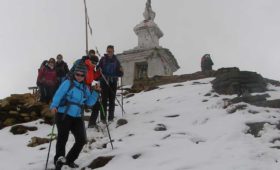The answer is fifty-fifty. It is not impossible to trek alone in some major tourist trails of Nepal such as Everest Base Camp, Annapurna Base Camp, Annapurna Circuit and Langtang-Kyanjin Gompa. However, we strongly advise you NOT to trek alone in high mountain areas of Nepal. Individual trekkers think that there are many fellow travellers in all regions and no guide or porter is necessary. They also consider a good map is enough to trek solo through those trails. But at the end of the day, you are just yourself in case of any emergency situation. Nobody has time to wait or even look at you. The emergency situation can be anything such as your health problems, physical injury, high altitude sickness or weather issues.
The other regulated trekking areas like Upper Mustang, Manaslu-Tsum Valley, Kanchenjunga, Upper and Lower Dolpa cannot be trekked alone or on your own. This is a Government provision that you must organize trekking permits through registered Trekking Companies and there should be minimum TWO persons to travel to those regions. Trekking Permits are special permits which are issued by Department of Immigration under Ministry of Home Affairs. There are separate permit fees for separate trekking areas. The local Trekking Companies are allowed to apply for those permits on your behalf and there are series of documents required in order to complete the application package. It is a provision that local support staff such as sardar, guide, porter, sherpa and cook should be included as per the necessity and cannot be trekked without hiring any support staff.
Why support staff is necessary?
We have realized that there are not ‘missing of a trekker’ reported from organized groups. The trekkers feel safer on guided trips. The guides are in frequent contacts with their company in Kathmandu. They also inform their company if any member of the group requires rescue from mountains. Helicopter Companies need some paper formalities in order to operate a rescue flight. Trekking Companies complete them on your behalf by contacting your insurance company. Then they fix an appointment with doctors in a hospital and contact your family member also. In your hard times in the mountains, your guide serves you like your family. He will also arrange someone to look after you if he needs to continue on trek with fit trekkers. The support staff is your great help in case of emergency. Most importantly, you are also supporting the local economy by creating job opportunities to the local people.
Some considerable points while trekking in Nepal:-
1- Insurance:
We strongly advise you to organize travel insurance in your home country that covers medical and air transport service.
2- Equipment:
We advise you to have proper gears for your designated trek. A full list of trekking equipment is available here.
3- Trekking Permits:
Local Trekking Companies can organize your National Park/Conservation Area Permits, TIMS Cards and Special Trekking Permits.
4- Guide and Porters:
Trekking Companies can provide you experienced and friendly guide and porters for your trek. There are guides who can speak specific language such as English, French, Spanish, Italian, Russian, Korean, Japanese, Chinese, Hindi etc. Porters relatively cannot speak English but they make your travel fun with their beautiful smile.
5- Local Money:
We advise you to carry local monies for your daily travel expenses. Banks or Money Exchange Centers can convert your money into local currency. You can use your Credit Cards also to pay to the Travel Companies.
6- A Map:
A recent map of the area would be good to keep together. This will give you general idea of the altitude and other relative information. Maps are available in local shops of Thamel.
7- Become a Responsible Traveller:
Be smart by choosing a responsible travel company. There are a few companies who are following responsible travel codes. Here are some tips on how to make a responsible trip.




